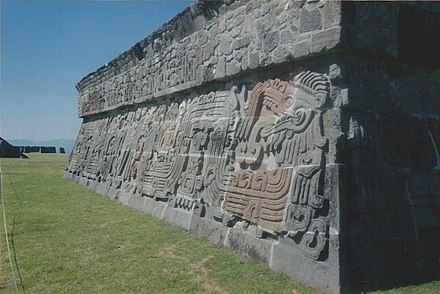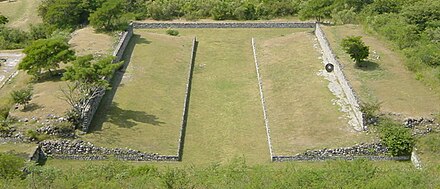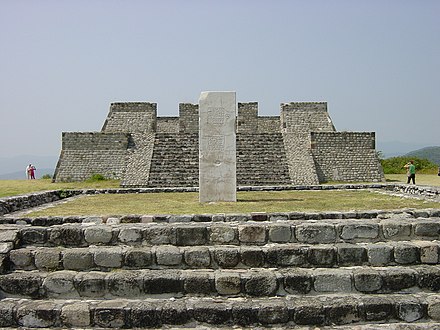Xochicalco - UNESCO World Heritage Site
Xochicalco is a large archaeological site in the central Mexican state of Morelos. Xochicalco is the 4th most visited archaeological site in Mexico, according to INAH. Unlike most Mesoamerican city-states, Xochicalco was a heavily fortified city so it has a different form and feel than other sites in the region. Xochicalco is a .
Understand
Xochicalco was not an Aztec city, nor from any of the peoples usually associated with Central Mexico. It was actually established by a Maya population called the Olmeca-Xicalanca who were originally traders from Campeche. It is a well-explored and preserved site that is noted for its Temple of the Feathered Serpent, several other pyramid temples, a large palace, three ballcourts, a spa, and an unusual observatory built to observe the sun by reflection. A large number of stelae, architectural adornments, and other artifacts were recovered by several archaeological expeditions. Some of these artifacts are on display in the site museum, others can be seen in the National Anthropology Museum in Mexico City.
History
 The time between 650 and 900 AD is referred to as the Epiclassic period'. It was an era of upheaval throughout southern and central Mexico. The biggest city-states in Mesoamerica all suffered defeat, depopulation, or destruction over a mere couple centuries. Xochicalco both rose and fell during the Epiclassic period, having been established about 650 and abandoned about 900. Sometime shortly after, the city was burned. Xochicalco had a very short lifespan compared to some of the great Mesoamerican cities like Chichen Itza, Tikal, or Monte Alban. Teotihuacan also fell during the Epiclassic time span, but probably earlier rather than later because historians surmise that Xochicalco may have played a role in that fall as the rising fortunes of Xochicalco coincided with Teotihuacan's decline.
The time between 650 and 900 AD is referred to as the Epiclassic period'. It was an era of upheaval throughout southern and central Mexico. The biggest city-states in Mesoamerica all suffered defeat, depopulation, or destruction over a mere couple centuries. Xochicalco both rose and fell during the Epiclassic period, having been established about 650 and abandoned about 900. Sometime shortly after, the city was burned. Xochicalco had a very short lifespan compared to some of the great Mesoamerican cities like Chichen Itza, Tikal, or Monte Alban. Teotihuacan also fell during the Epiclassic time span, but probably earlier rather than later because historians surmise that Xochicalco may have played a role in that fall as the rising fortunes of Xochicalco coincided with Teotihuacan's decline.
When the city was destroyed, some of the people moved down the hillside and engaged in light subsistence farming. The Nahua laid claim to Xochicalco in 1200 AD and re-populated the city.
Restorations have been taking place at the site almost continually for more than a century. Leopaldo Batres of the National Anthropology Museum led the efforts i 1910 to restore the Temple of the Feathered Serpent. Major excavations and renovations were done between 1940 and 1960. A Penn State University expedition in 1976 mapped the site and excavated obsidian workshops. A 1988 INAH expedition excavated major monuments at the site.
Landscape
Xochicalco is a hilly site in rural Morelos. The main ceremonial center sits atop a leveled hilltop. Remains of residential structures are mostly unexcavated and lie on terraces along the slopes of the hill.
Architecture
 Structures at Xochicalco reflect Mayan design elements with a many of the buildings being decorated with sculptured relief panels. The carvings appear sharp and well-defined with the Temple of the Feathered Serpent depicting Mayan gods and the upper levels of the pyramid depicting vassal communities paying tribute to Xochicalco.
Structures at Xochicalco reflect Mayan design elements with a many of the buildings being decorated with sculptured relief panels. The carvings appear sharp and well-defined with the Temple of the Feathered Serpent depicting Mayan gods and the upper levels of the pyramid depicting vassal communities paying tribute to Xochicalco.
The Observatory is quite different from observatories at other Maya sites in that it wasn't built to observe objects in the night sky, but rather to observe the sun during the late spring and early summer, especially during the solstice. To do this, a chimney was built that would capture a narrow view of the sun's light with the brightest light coming as the sun was directly overhead.
Climate
The weather in Xochicalco is normally sunny and hot with cool evenings. April is the hottest month with average temperatures between 18 and 35 C and December being the coolest month with average temperatures between 14 and 28 C. Summer is the rainy season with average monthly precipitation over 100mm from June through October. December through April are good months for traveling to Xochicalco because it almost never rains.
Get in
By bus
From Mexico City, go to the Taxqueña bus terminal where you'll need to take a bus to Xochitepec. Buses leave at least hourly. Tickets cost M$100 and the bus ride takes 1 hour. In Xochitepec you can take a taxi the last 15 KM.
Direct buses to the site leave from Cuernavaca and cost as little as M$50.
By car
Use highway MEX 95D (Carretera Mexico-Acapulco), until you reach the exit to Alpuyeca. Follow the signs to MEX 166 to Miacatlán for 12 miles, you'll turn off well before Miacatlan, follow the signs to the archaeological zone (Zona Arquelogico Xochicalco), the parking lot is 4 KM from the turnoff. (If you pass a lake called El Rodeo, you missed the turnoff. Turn around and watch for the turnoff.)
Fees and permits
The entrance fee is M$90 (January 2023). The site is open from 09ː00 - 17ː00 daily.
Get around
It's an archaeological site...you walk (and sometimes climb).
See
- Museo de Sitio de Xochicalco - the official site museum, opened by INAH in 1996. Features interpretive exhibits about the ruins, their history, and culture of the people who built it and lived there. Several stone statues recovered from the ruins including a few that reflect the kind of polished attention to detail found in fine art collections (surprising, given that many stone objects from the era appear rough in texture and workmanship).
Do
- explore one of the most unique pre-Colombian ruins in Central Mexico
Buy
A small souvenir shop is part of the Site Museum.
Eat
There are no restaurants at or close to the site. The nearest restaurant is on the main road (Carr. Alpuyeca-Grutas de Cacahuamilpa).
- Restaurante La Pasadita, Carretera Alpuyeca- Grutas de Cacahuamilpa Km.8, Xochicalco, 18.779644°, -99.300496°, +527773406440. 09ː00 - 18ː00. Super casual open-air patio restaurant with a buffet lunch available. They have a fish tank and will serve you a fresh-from-the-tank fish prepared as you likeː mojo de ajo, a la diablo, etc. M̩150 2023-01-17
Drink
Bring bottled water. At least 2 liters per person.
Sleep
There are some small, locally owned hotels and posadas on the road between Miacatlan and Xochicalco. A few of them are listed below.
Lodging
- Quinta la Cascada Miacatlan, La Toma, Miacatlán, 18.769354°, -99.344639°. Check-in: 15ː00, check-out: 12ː00. Super small family run country inn, friendly and inexpensive, large rooms. 2023-01-17
- Quinta los Amigos, Carretera Alpuyeca-Grutas de Cacahuamilpa Km. 9.5, El Rodeo, 18.782096°, -99.306096°, +52 5555948467. More of a retreat kind of place. Camping available. 2023-01-17
- Hotel el Gallego, Camino Aldique S/N, Carr. Fed, Alpuyeca - Grutas de Cacahuamilpa, Miacatlán, 18.774051°, -99.326609°, +52 7374880092. Check-in: 15ː00, check-out: 12ː00. Peaceful, family friendly hotel. Swimming pool but no a/c. 2023-01-17
Stay safe
- Protect yourself from the sun - sunshine at the site can burn faster than you might expect, bring sunblock and a hat
- Hydrate yourself - drink enough water, bring at least 2 liters for an afternoon at the site
- Wear tough shoes - walking the site can be hard on your feet to begin with, the terrain here is often rocky and there is a lot of climbing
Go next
- Grutas de Cacahuamilpa National Park - explore one of the largest cavern systems in Mexico
Xochicalco
Timezone:MultipleCoordinates:18.80, -99.30
